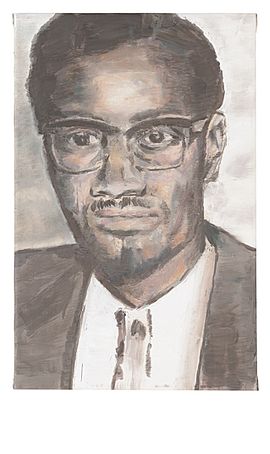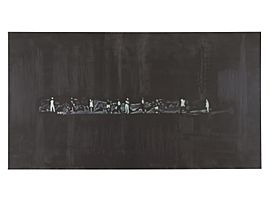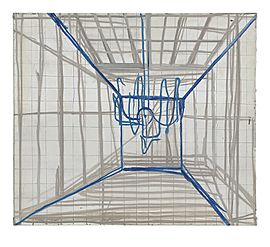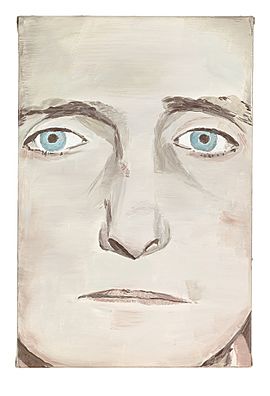Luc Tuymans facts for kids
Quick facts for kids
Luc Tuymans
|
|
|---|---|

Tuymans in 2009
|
|
| Born | 14 June 1958 Mortsel, Belgium
|
| Education |
|
| Known for | |
| Spouse(s) |
Carla Arocha
(after 1999) |
| Awards |
|
Luc Tuymans (born 14 June 1958) is a famous Belgian artist. He is best known for his paintings that explore how people remember history. His work often deals with big historical events, especially World War II.
Tuymans became a well-known painter at a time when many people thought painting was becoming less important because of computers and digital images. His paintings often look blurry or out of focus. This is not an accident. He carefully paints them this way to make them look like faded memories or old photographs.
He gets his ideas from many places, like news photos, movie scenes, and even his own drawings. His paintings cover a wide range of subjects, from serious historical events like the Holocaust to everyday things like wallpaper or Christmas decorations. The titles of his paintings are also very important. They often add another layer of meaning and make the viewer think more deeply about what they are seeing.
Contents
Early Life and Education
Luc Tuymans was born in Mortsel, Belgium, in 1958. His family had different experiences during World War II. His mother's family was part of the Dutch Resistance, helping to hide people. Some of his father's family members were said to have sympathized with the Nazis. This family history made Tuymans think a lot about good and evil, which later became a major theme in his art.
He showed a talent for art from a young age. He once won a drawing competition during a summer holiday, which made him feel that art was his path in life.
Tuymans studied art at several schools in Brussels and Antwerp. For a while, he stopped painting to experiment with making films. He later returned to painting with a new, faster technique. He decided to finish each painting in a single day. He also studied Art history at a university.
Famous Paintings and Themes
Exploring History and Memory
Many of Tuymans' early paintings are about World War II and its aftermath. He wanted to explore if art could still be meaningful after such a terrible event.
One of his most famous paintings from this time is Gaskamer (Gas Chamber) from 1986. It is a painting of a room in the Dachau concentration camp, based on a watercolor he made there. The painting is pale and simplified, which makes the viewer think about the horrors that happened in that place.
Another important work is Die Wiedergutmachung (The Reparation) from 1989. It shows the eyes of children who were harmed in experiments by the Nazis during the war. These paintings challenge viewers to remember difficult parts of history.
Portraits and Everyday Objects
Besides historical subjects, Tuymans also paints portraits. But his portraits are not meant to show a person's personality. Instead, they often look like masks or empty shells. This makes the viewer think about identity and how we see other people.
An example is the series Der diagnostische Blick (The Diagnostic Look) from 1992. These paintings were based on pictures from a medical book. They show parts of the body in a cold, clinical way.
Responding to World Events

Tuymans often responds to political and social events through his art. In 2000, he created the series Mwana Kitoko (Beautiful Boy). It was inspired by a visit of the Belgian king to the Congo in the 1950s, when it was still a Belgian colony.
After the 9/11 attacks in New York, many people expected him to create a painting about it for a major art show called Documenta 11. Instead, he showed a huge painting of a simple still-life. He said he wanted to create an "anti-picture," a peaceful image in response to the terrible event.
Dispute Over a Photograph
In 2015, Tuymans was involved in a legal dispute. A photographer named Katrijn Van Giel said that Tuymans' painting A Belgian Politician was a copy of her photograph. Tuymans argued that his painting was a parody, or a critical commentary. They later reached a private agreement to settle the issue. This case started a conversation about how artists use existing images in their work.
More Than Just Paintings

Oil on canvas, 194.2 × 353.7 cm, 761⁄2 × 1391⁄4 inches, Collection Tate Modern, London.
Presented by the artist and David Zwirner, 2016
Besides painting on canvas, Tuymans works in many other forms.
Works on Paper
Drawing is a very important part of his process. He makes many sketches and watercolors to develop his ideas before starting a painting. He has said that drawing helps him think and that he often draws from memory.
Murals and Mosaics
Tuymans has created about 50 murals, which are large paintings done directly on a wall. Some are permanent, while others are temporary for exhibitions.
He has also designed large mosaics. One famous mosaic is Dead Skull (2010), located in a public square in Antwerp. It is made of almost 100,000 small stones in 11 different colors. From the ground, it's hard to see the image. But as you go up in the nearby MAS museum, the image of a skull becomes clear.
Prints
Tuymans also makes prints using various techniques like etching and screen printing. Like his paintings, his prints are often based on photos or film stills that he has changed until they look blurry and mysterious.
Sharing His Knowledge
Tuymans is not just an artist; he is also a teacher and a curator. A curator is someone who organizes art exhibitions.
He has curated many shows, often bringing together art from different cultures, like Belgium and China. One of his goals as a curator is to create a conversation between different artworks.
He has also worked as a guest teacher at art schools, helping to guide and inspire a new generation of painters. He often gives lectures and talks about his work at museums and universities around the world.
Recognition and Legacy
Luc Tuymans is considered one of the most important painters of his generation. His work is shown in major museums all over the world, including the Tate Modern in London, the Museum of Modern Art (MoMA) in New York, and the Centre Pompidou in Paris.
His paintings are highly valued and sell for large amounts of money at auctions. He has received many awards and honors for his contributions to art, including an honorary doctorate from the Royal College of Art in London.
Tuymans continues to live and work in Antwerp. He is married to the artist Carla Arocha. His unique style and thoughtful approach to history have had a big influence on contemporary painting.
Selected museums and public collections
- 21st Century Museum of Contemporary Art, Kanazawa, Japan
- Albright–Knox Art Gallery, Buffalo, New York
- Art Institute of Chicago, Chicago
- Berkeley Art Museum and Pacific Film Archive, University of California, Berkeley
- The Broad, Los Angeles
- Carnegie Museum of Art, Pittsburgh
- Centre Pompidou, Paris
- Dallas Museum of Art, Dallas
- De Pont Museum of Contemporary Art, Tilburg, The Netherlands
- Des Moines Art Center, Iowa
- Fonds Régional d’Art Contemporain (FRAC) Auvergne, Clermont-Ferrand, France
- Friedrich Christian Flick Collection, Hamburger Bahnhof – Museum für Gegenwart, Berlin
- Fundacion de Serralves, Porto
- Hammer Museum, Los Angeles
- Hirshhorn Museum and Sculpture Garden, Washington, DC
- HVCCA – Hudson Valley Center for Contemporary Art, Peekskill, New York
- The Israel Museum, Jerusalem, Jerusalem
- Kunstmuseen Krefeld, Germany
- Kunstmuseum aan zee (Mu.ZEE), Ostend, Belgium
- Museum of Fine Arts Bern, Bern
- Kunstmuseum Wolfsburg, Wolfsburg
- LACMA Los Angeles County Museum of Art, Los Angeles
- Louisiana Museum, Humlebaek, Denmark
- Musée des Beaux-Arts de Nantes, Nantes
- Museum für Moderne Kunst, Frankfurt
- Museum of Contemporary Art, Antwerp, Antwerp
- Museum of Contemporary Art Chicago, Chicago
- The Museum of Modern Art, New York
- Over Holland Collection, the Netherlands
- Philadelphia Museum of Art, Philadelphia
- Pinakothek der Moderne, Munich
- San Francisco Museum of Modern Art, San Francisco
- Stedelijk Museum voor Actuele Kunst, Ghent
- Solomon R. Guggenheim Museum, New York
- Tate Gallery, London
See also
- List of Belgian painters
- New European Painting





